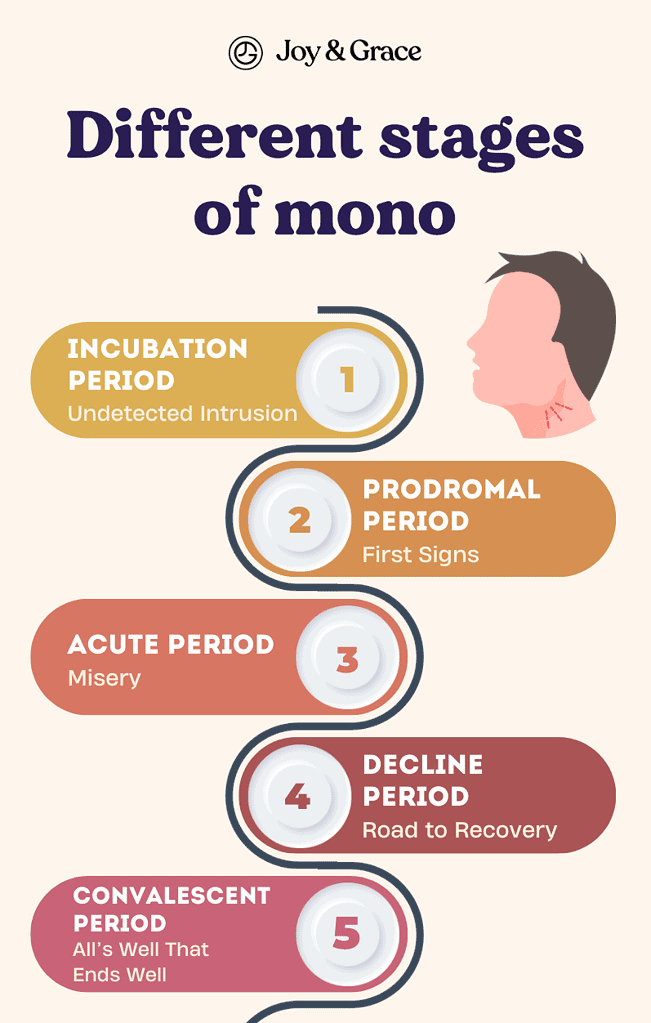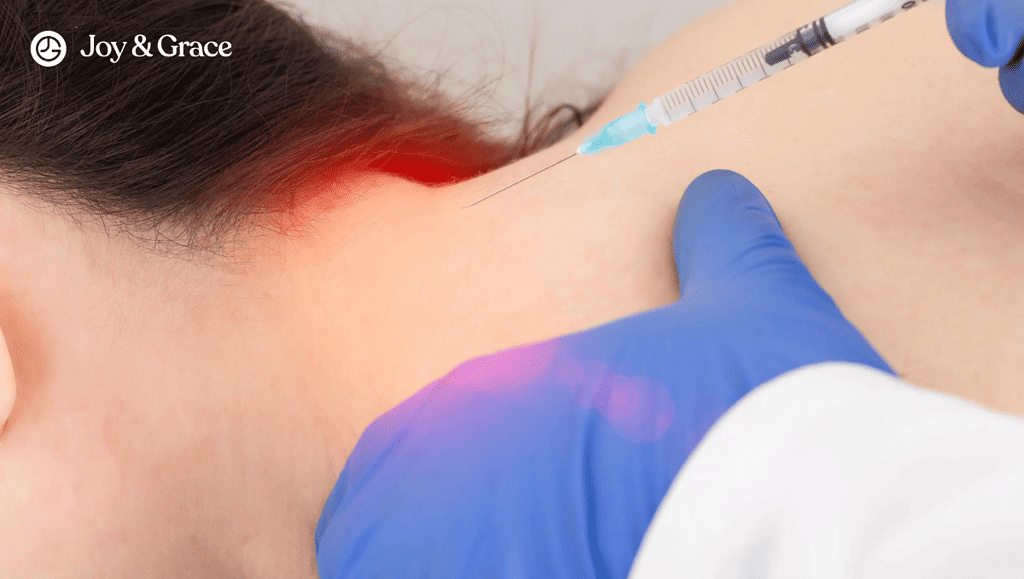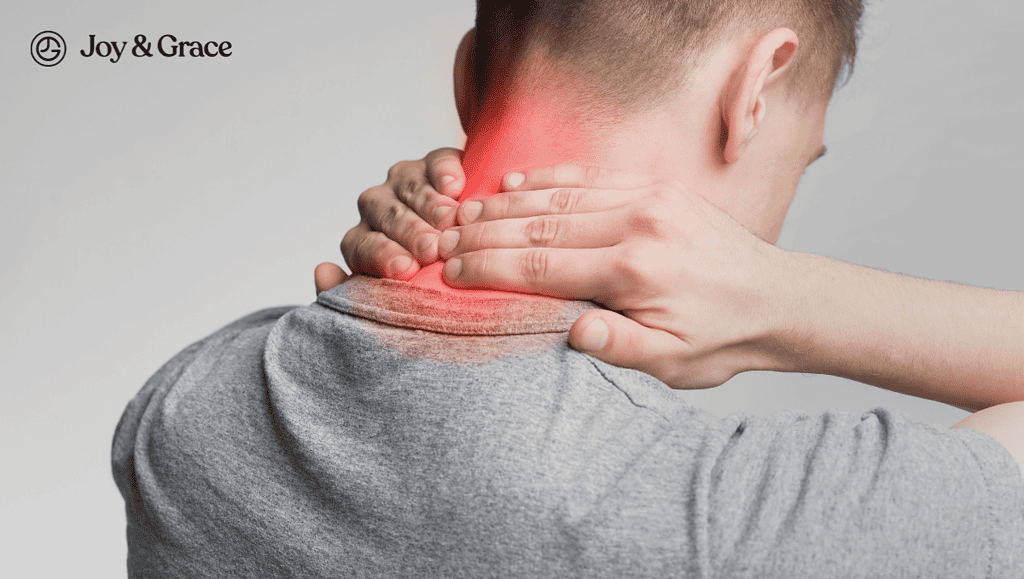A throwback to younger days, everyone's probably heard of the "kissing disease" growing up called mono, which is short for mononucleosis. It is caused by a virus and is easily spread by sharing food or being in close contact with someone who has it. Teens spend some time with a cough and fever, eventually getting better. Some people might have a second round with mono. But is neck pain common with mono, and what can we do about it?
Can You Have Neck Pain with Mono?
Yes, you can have neck pain with mono.
Mono causes neck pain in two main ways:
- Mono causes the lymph nodes in the neck to swell, making the area around them sore and tender. Swollen lymph nodes are a hallmark of the disease and are present in 100% of patients.
- Mono can also directly cause joint pain, with the neck included. Although not as common a mechanism as the first one, the Epstein-Barr virus that causes Mono is still well known to cause joint pain and other types of body aches.|
In short, the Epstein-Barr virus can cause swollen lymph nodes and joint pain, which can cause neck pain.
Mono can also cause aches in different parts of the body, like the shoulders, back, arms, and legs.
If you have neck pain or other symptoms of mono, you should talk to a doctor to get a correct diagnosis and advice on how to deal with the pain. Rest, staying hydrated, and caring for yourself are all important to getting better.
Main Symptoms Of Mono
After catching the EBV infection, typical infectious mononucleosis symptoms usually appear four to six weeks later. Not all symptoms will manifest simultaneously, and some may take time to appear. These symptoms include
- Extreme exhaustion (fatigue)
- Fever
- Sore throat
- Head and body aches (with the neck and shoulder included)
- Swollen lymph nodes in the neck and armpits
- Enlarged spleen, liver, or both
- Rash
Less frequent symptoms include a bloated liver and an enlarged spleen. Some people may still have enlarged livers, spleens, or both, even when the fatigue is gone.
The majority of people recover in two to four weeks; however, some may continue to feel tired for longer periods of time. In some instances, the signs and symptoms of infectious mononucleosis might persist for up to six months.
Can Mono Cause Shoulder Pain?
Shoulder pain in Mono must be discussed in a little more detail.
First:
- Mono without spleen involvement does not commonly cause shoulder pain.
While, as we mentioned earlier, Mono can cause all types of joint pain (with the shoulder included), this is still not very commonly reported.
This brings us to the second point:
- If you have Mono and feel left shoulder pain that worsens when breathing deeply, it might be a sign of spleen swelling (enlargement).
Mono causes a swollen spleen in about half of the cases. It usually felt like upper left abdominal pain that can radiate to the left shoulder.
Let’s discuss this even further.
Does Mono Cause Pain in the Left Side?
The left side or flank of the body houses the spleen, an organ that plays a role in the immune system:
- It fights any invading germs in the blood (the spleen contains infection-fighting white blood cells).
- It controls the level of blood cells.
- The spleen controls the level of white blood cells, red blood cells, and platelets (small cells that form blood clots).
Because the spleen is a “fighting ground” against mono, it can sometimes swell up during the infection, hurting your left side.
That’s why doctors suggest avoiding contact sports and heavy lifting for a few weeks if the spleen gets bigger.
This advice is given to avoid a rare complication called splenic rupture, which can happen after a trauma or on its own.
When the spleen ruptures, there’s extreme, sudden, and sharp pain on the left, by the bottom of the ribs. Splenic rupture is a medical emergency; hence, you should see a doctor immediately if you have severe pain, a fever, and other throat and neck symptoms.
If you want further information:
Splenic rupture is a rare complication of Mono that could be fatal. It is thought to happen in one to two out of every 1,000 people.
When a spleen ruptures, it happens on its own in more than half of the cases. It usually happens 14 days after the first signs of illness, but it can take anywhere from four days to eight weeks. It can sometimes be the first sign of a problem.
Treating a ruptured spleen is the same as other kinds of spleen injuries. The best treatment is non-surgical care, which includes intensive support and keeping the spleen, but some people need to remove their spleens. Even though Infectious Mononucleosis-related splenic rupture can be life-threatening, fatality from it is luckily rare.
Can Mono Cause Joint Pain?
Mono can indeed cause joint pain, as we mentioned earlier. Moreover, mono can also cause muscle aches and other types of body aches, further contributing to the discomfort experienced by those affected.
However, it's important to note that joint pain and other body aches are not as common as other symptoms associated with mono.
Individuals with mono typically experience symptoms such as:
- Swollen lymph nodes
- Fatigue,
- Sore throat,
- Fever,
- Enlarged tonsils, etc.
These symptoms are more prevalent and typically occur earlier during the illness.
To sum it up: While joint pain is a possible manifestation of mono, it’s usually not the disease's primary or most common symptom.
Your Complete Guide To Mono - Everything Else You Need To Know
What Is Mononucleosis (Mono)?
Mononucleosis, or mono, is an infection caused by the Epstein-Barr virus (EBV). EBV is a type of virus that is found in the bodily fluids (such as alive or blood) of an infected person. This can be spread through:
- Kissing or any other activity that transfers saliva (such as eating or drinking from the same cup)
- Sexual contact,
- Blood transfusions, and
- From mother to child during pregnancy or breastfeeding.
Although infants and young kids with mono usually have very mild symptoms, it can be serious for those with weakened immune systems. Mono can cause fever, a sore throat, swollen lymph nodes, body aches, and fatigue. Mono can also cause a rash, although this is rare. Thankfully, most people with mono recover within a few weeks with no lasting effects.
How Is Mononucleosis Diagnosed?
When someone goes for a medical checkup, a doctor may suspect mono based on the presence of mono symptoms. These typically focus on a fever, sore throat, and swollen lymph nodes. If confirmatory tests are needed, there is a blood test for mono. It is the Epstein-Barr virus (EBV) antibody test.
What Are the Warning Signs of Mononucleosis
Talk to your doctor if:
- You have a severe sore throat for over a day or two or mono symptoms for more than 10 days. Your doctor will want to rule out other medical conditions, like a strep throat infection.
- You have a severe headache that won't go away and a stiff neck, which could be symptoms of meningitis.
- You develop a rash with numerous tiny red spots called petechiae, which may indicate meningitis or a serious illness like a lack of platelets in your blood.
- You have jaundice, which is a sign of possible hepatitis that manifests as yellow skin or eyes.
- You have symptoms of other illnesses, such as enlarged lymph nodes all over your body, breathing difficulties, a persistent fever of more than 101.5 degrees Fahrenheit, or weakness in your arms and legs.
What Are the Stages of Mono?

A mono infection can last for months. But the length of time that symptoms last can vary. They may only last for two to six weeks, but some people can have lingering effects, especially fatigue.
Even after the symptoms have gone away, the virus can still be spread through saliva for up to three months. In stubborn cases, mono could still be contagious to some degree for as long as 18 months!
Below are the different stages of mono so you know what to expect.
Incubation Period: Undetected Intrusion
The first stage is the incubation period. At this time, the virus is multiplying inside the body, but there are no symptoms yet.
Prodromal Period: First Signs
The next stage of mononucleosis, the prodromal period, is when symptoms first appear.
How long it takes for a patient to develop symptoms can vary from 4 to 6 weeks. These symptoms generally last between 3 and 5 days.
Often, a person may go through the prodrome stage without having any symptoms at all.
If you have low energy or feel off, it is best to stay at home, get plenty of rest, and avoid socializing.
This will help your body recover and prevent you from spreading anything to anyone else.
Acute Period: Misery
The next phase of mono is the illness period. During this time, symptoms may start to worsen. Acute symptoms are commonly known as "classic" symptoms.
By and large, the acute stages of mono last for 2–6 weeks but may persist longer for some patients.
Not everyone will experience the complete set of symptoms from mono. Also, mono symptoms can show up at any time during the course of an infection.
During this stage, you might feel that your sore throat worsens and your fever increases.
Swollen glands and aches throughout the body are also more likely at this stage, as is worsening fatigue.
Decline Period: Road to Recovery
The decline period is when symptoms improve.
During this phase, someone starts to recover from mono. The decline phase lasts anywhere from 3 to 6 months.
By this stage, most symptoms have improved. However, you may still feel weak and fatigued. During this time, if you have an inflamed or enlarged spleen, you should avoid any physical activity that might cause it to rupture.
Some people may feel weak or exhausted during this period, which may continue for a long while.
Convalescent Period: All’s Well That Ends Well
The final stage is the convalescent period. This is when the person has fully recovered from mono.
Quick Note about Stages
Trivia time: The stages that we just described aren’t specific or unique to the progression for mono. The medical field has actually more or less standardized on these stages of infection in general for most diseases.
If you suspect you may have mono, feel free to impress your primary care doctor and win brownie points by asking him if you’re in “prodrome”, “prodromal period”, or “prodromal stage” of mono. Maybe he’ll give you a lollipop. 🙂
What Causes Mono to Flare Up?
Unlike usual viruses, EBV stays in the body even after someone recovers from mono. Most people get sick with mono in their teens and never have to deal with it again. This is because the body's immune system is strong enough to keep it in check and out of the foreground.
In some people, EBV can reactivate many years later. This is usually called a "flare-up." This happens when the immune system is weak, which can be due to several reasons, including:
- Stress
- Lack of sleep
- Poor nutrition
- Alcohol
- Smoking
- Autoimmune diseases
If you are experiencing any symptoms of mono, see your healthcare provider to rule out other potential causes.
What Would Happen if Mono Is Left Untreated?
Mono typically does not need dedicated treatment. Most of the time, a doctor or specialist can give you medication or treatments to help with pain, swelling, and fever.
Although mono usually resolves itself, it can rarely lead to serious health complications. Some of these can even be life-threatening emergencies, such as:
- An enlarged spleen, which can rupture and cause internal bleeding
- Liver damage
- Heart problems
- Neurological problems
We still strongly recommend seeing a doctor for mono. This way, you can receive the correct guidance and monitoring to prevent complications.
How Long Is Mononucleosis Contagious?
Mononucleosis is a highly contagious viral infection. The incubation period for the virus is typically 4-6 weeks. This means a person is most contagious for up to 6 weeks after infection while they are actively feeling symptoms. Even after the symptoms have gone away, the virus can still be spread through saliva for up to three months and could be contagious for up to 18 months.
After this, the chances of spreading the virus gradually lower over time. But because EBV stays in the body for life, the chance of passing mono to others is never truly zero. In addition, it is also possible to spread mono by accident even before symptoms appear, but this is also rare.
How Is Mononucleosis Treated?

There is no specific treatment for mono, but there are ways to relieve symptoms and speed up recovery. Supportive care can make a big difference in ensuring someone with mono is as comfortable as possible. Treatment for mono generally includes:
- Bed rest
- Drinking plenty of fluids
- Taking over-the-counter medicine like ibuprofen or acetaminophen
- Avoiding contact sports or other vigorous activities that could cause further injury
- Applying ice to swollen lymph nodes
If you have risk factors that include a weak immune system, your doctor may tell you to take antiviral medication. It is best to talk to a licensed doctor to get advice on how to get the best care for yourself.
Takeaway
Mono can be a blast from the past, and a much-unwanted guest, at that. It is a viral infection caused by EBV, which stays in the body even after recovery. Mono or EBV flare-ups usually cause fevers, sore throat, and swollen lymph nodes in the neck, which can be painful and uncomfortable at any age. But with enough tender loving care and proper guidance from a doctor, it doesn't have to be a total pain in the neck!
Got any mono stories to share in the comments below? (Or other good memories around that time?) Stay up to date with our other health guides.















